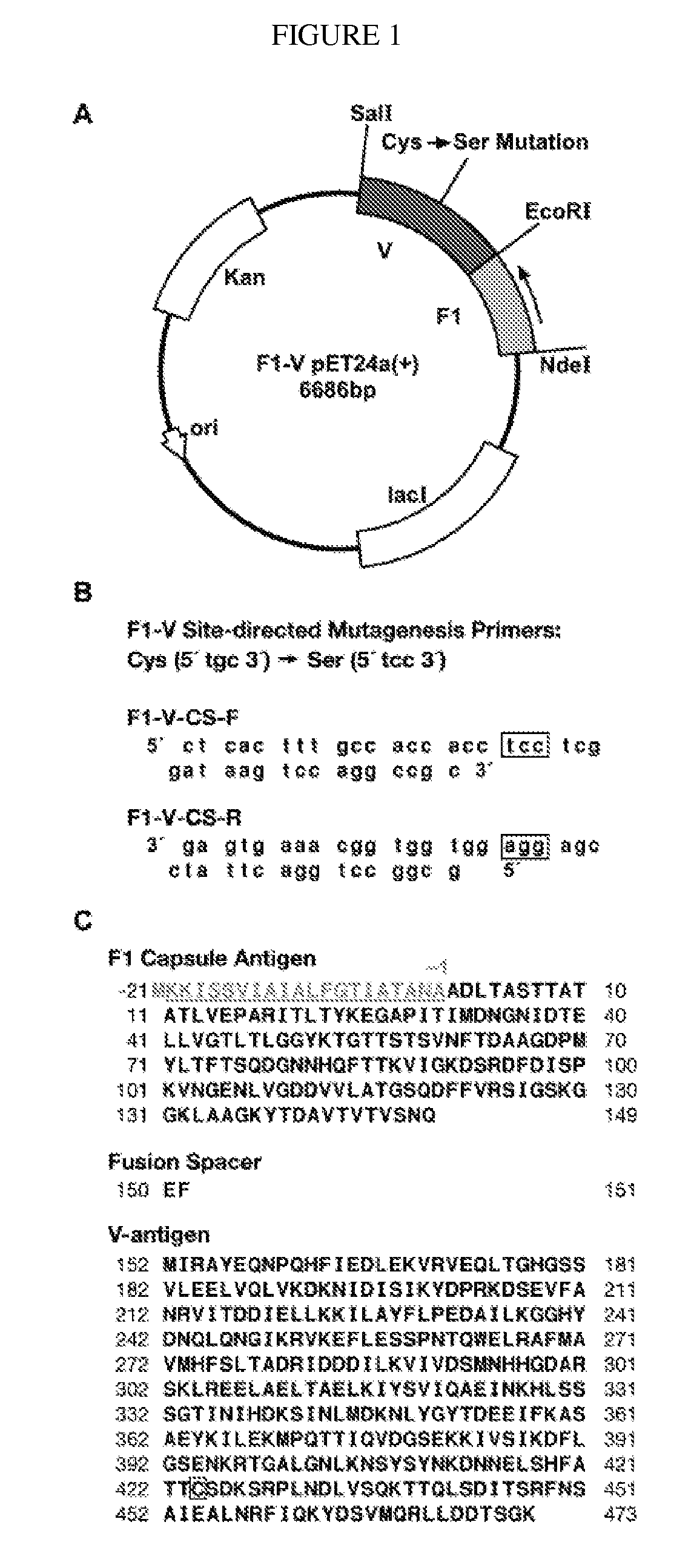Purification and protective efficacy of monodisperse and modified yersinia pestis capsular f1-v antigen fusion proteins for vaccination against plague
a technology of capsular f1-v and yersinia pestis, which is applied in the field of compounding and methods, can solve the problems of low process yield, common side effects, and failure to fully realize the development of vaccines using only fl antigens, and achieve the effect of inhibiting yersinia pestis infection
- Summary
- Abstract
- Description
- Claims
- Application Information
AI Technical Summary
Benefits of technology
Problems solved by technology
Method used
Image
Examples
example 1
Materials and Methods
[0162]This Example describes materials and methods that were used in performing Examples 2-16, below. Although particular methods are described, one of skill in the art will understand that other, similar methods also can be used.
Bacterial Strain, Plasmid Construction, Cultivation, and Induction
[0163]For F1-VMN the E. coli strain BLR130 and the F1-V expression vector, pPW731 (USAMRIID), controlled under a T7 promoter, were used for F1-V expression (Powell et al., (2005) Biotechnol. Prog. 21 (2005), pp. 1490-1510). A growth medium of soytone, yeast extract, and glucose (J. T. Baker, Phillipsburg, N.J.) and the antibiotics kanamycin (30 mg / L) and tetracycline (15 mg / L; Sigma, St. Louis, Mo.) were used in phosphate buffer, pH ˜7.3. Sterile medium in shaker flasks (300 ml) was inoculated with 1 ml of the strain from a previously made glycerol stock and incubated for ˜13 hours at 37° C. with shaking at 220 rpm. Batch cultivations were carried out in a Bioflo 4500 (Ne...
example 2
F1-VMN and F1-VC424S-MN Expression
[0184]This Example demonstrates the expression of two F1-V fusion proteins, F1-VMN and F1-VC424S-MN. In order to evaluate the effect of super molecular structure (for instance, its state of aggregation) of the F1-V-based plague vaccine antigen on protective efficacy and to facilitate vaccine production, the sole cysteine (C424) in F1-V was replaced with a serine residue by site-directed mutagenesis. Standard F1-VMN and the modified F1-VC424S-MN proteins were independently over-expressed in E. coli, recovered by mechanical lysis / pH-modulation, and purified from urea-solubilized, soft inclusion bodies with successive ion-exchange, ceramic hydroxyapatite, and size-exclusion chromatography stages as described in Example 1. Aggregation characteristics for the purified proteins were characterized and compared under variable pH and buffer solution-additive conditions. The biological activities of the two purified proteins in various super molecular states ...
example 3
Ion-Exchange Chromatography
[0187]This Example demonstrates the purification of both F1-V and the variant F1-VC424S. Standard F1-V and the F1-VC424S variant purified similarly through the ion-exchange stages of the improved process. Profiles from purification of the standard (cysteine-containing) F1-V performed at the larger scale are shown (FIG. 4). The Q-Sepharose FF chromatography stage, performed under partially dissociating conditions and eluted with the denaturing Gdn cation, was effective as a charge-based step for isolating F1-V (FIG. 4A). F1-VC424S monomer eluted at Gdn HCl concentrations below 100 mM, similar to what was observed with F1-VSTD-MN. Dimer and trimer forms of F1-V remained intact during reducing SDS-PAGE analysis when samples were prepared by heating to less than 70° C. for 10 minutes. These same forms were dispersed and ran as apparent F1-V monomers when heated to 100° C. for 10 minutes, corroborating prior observations of strong self association F1-V by gel e...
PUM
| Property | Measurement | Unit |
|---|---|---|
| Fraction | aaaaa | aaaaa |
| Fraction | aaaaa | aaaaa |
| Molar density | aaaaa | aaaaa |
Abstract
Description
Claims
Application Information
 Login to View More
Login to View More - R&D
- Intellectual Property
- Life Sciences
- Materials
- Tech Scout
- Unparalleled Data Quality
- Higher Quality Content
- 60% Fewer Hallucinations
Browse by: Latest US Patents, China's latest patents, Technical Efficacy Thesaurus, Application Domain, Technology Topic, Popular Technical Reports.
© 2025 PatSnap. All rights reserved.Legal|Privacy policy|Modern Slavery Act Transparency Statement|Sitemap|About US| Contact US: help@patsnap.com



